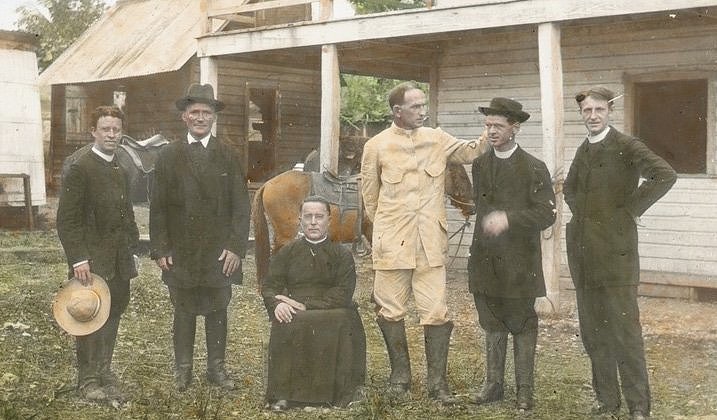
By Kris Mackey and David Hart
When Philip Kemper emigrated from Wallhausen, Germany, to the United States in the late 1800s, we know that he carried very little materially, but brought along his greatest assets according to his great-nephew Will Kemper.
The assets he carried were his strong character, resourcefulness, common sense, and a deep Catholic faith that led to a hopeful and positive attitude. Eventually settling in Dayton, Ohio, with his wife Mary, they raised seven children in their home parish of Emmanuel Catholic Church. Philip opened a religious goods store selling vestments, Bibles, statues, books, and other Catholic materials. His work was aligned with his passion for living a life of faith—and perhaps born from his journey to America which was buoyed by that same faith. What is amazing about this couple is five of their seven children entered religious orders, with three becoming Jesuits. The family’s Catholic faith became the family business.
Between 1894 and 1902, the five young Kempers said goodbye to their first family and invested all of themselves in an exciting new life that held promise for the future. The eldest was Helen, who entered the Poor Sisters of St. Francis at age 20 and became Sr. Mary Alacoque, SPSF. Three of the four brothers joined the Society of Jesus at Florissant, Missouri: Francis “Frank” in 1896, Aloysius “Al” in 1900, and Joseph “Joe” in 1902. Clara joined the Sisters of Notre Dame de Namur at their novitiate in Cincinnati, becoming Sr. Mary Kostka, SNDdeN.
All of the Kemper children were quite accomplished and tremendous contributors in their own ways. Sister Mary Kostka was missioned to Japan from the motherhouse in Massachusetts and became a missionary there. She later taught stateside at Trinity College before returning to Japan after the war and became president of the Okayama Seishin Women’s University in Okayama in western Japan.
Sister Mary Alacoque became provincial of her order, then headquartered in Aachen, Germany, and at one time had four hospitals in the Ohio region under her supervision, including St. Mary’s Hospital in Cincinnati, which was founded in a vacated orphanage to serve the German immigrant population; St. Anthony Hospital in Columbus, Ohio; and St. Elizabeth Hospital in Covington, Kentucky. In 1959, the American province of the congregation separated from it, to become an independent congregation called the Franciscan Sisters of the Poor, now headquartered in Brooklyn, New York.
Father Joseph Kemper, SJ, was a Spanish-speaking missionary in the British Honduras (now Belize) for 44 years. There he taught and was treasurer at St. John’s College, later becoming pastor at three different churches. He was remembered as a generous and kind priest, as well as a great violinist and storyteller.
A Japanese woman prays at the grave of Sr. Mary Kostka, SNDdeN.
Father Aloysius Kemper, SJ, was a scholar, studying and teaching at the Pontifical Gregorian University in Rome. He was also deeply spiritual and a talented retreat master. Besides the many retreats for Jesuits, he ministered to more than a dozen women’s religious orders, to the Franciscan Brothers, and to the Holy Cross Brothers. Father Al was a respected theologian, focused on a body of knowledge known as “dogmatic theology,” and spoke five languages.
Father Francis Kemper, SJ, worked at many schools, including University of Detroit High School and Saint Ignatius High School in Cleveland. But he was most known for his work with Jesuits in training at Florissant, Missouri; Milford, Ohio; and West Baden College, Indiana. He also trained diocesan priests at Mundelein, Illinois, and finished his ministry at the Alexian Brothers Novitiate in Gresham, Wisconsin. One of his greatest achievements was the building of the chapel at the novitiate in Florissant. While rector there, Fr. Frank raised the money and helped design and oversee the construction of the chapel. The term then for “fundraiser” was “collector,” and he proved himself worthy of the title. The main building of the novitiate had been built in 1840 from limestone quarried from the banks of the Missouri River, and Fr. Pierre-Jean De Smet, a great builder of Jesuit works, was there at one time. The chapel was a wonderful addition to the campus.
How were these siblings able to live such holy and giving lives of service so consistently? The support these priests and nuns received from their lay brother and sister, all of their nieces and nephews, their aunts and uncles and cousins, and their parents cannot be understated. Nor can the diverse, rich religious communities whose love enveloped them be overlooked. Such is the joy of religious life—loved by many communities. But the tale of one family leads us to also consider the Kemper family business in a larger context. How do young people gravitate toward their calling? Why did Peter and Jane Fonda become successful in the movie industry? Why is LeBron James’ son Bronny seeking a career in the NBA? How is it that young Richard Daley became a mayor? It is because they had positive examples and mentorship—much like the Kemper children? Such is the way of any family business.
Is it possible for us all—as aunts and uncles, parents, siblings, grandparents, teachers, and friends—to provide the same silent guidance as it relates to a faith-filled life? Perhaps someday faith-filled people or faith leaders will point to one of us and remark, “Her devotion was my inspiration” or “The way he lived his life motivated me to do the same.” We don’t need to run a religious goods store; in fact, we need no words. Maybe we only need to show our faith by the manner in which we live our lives. Maybe we all have the ability to create such a family business.





